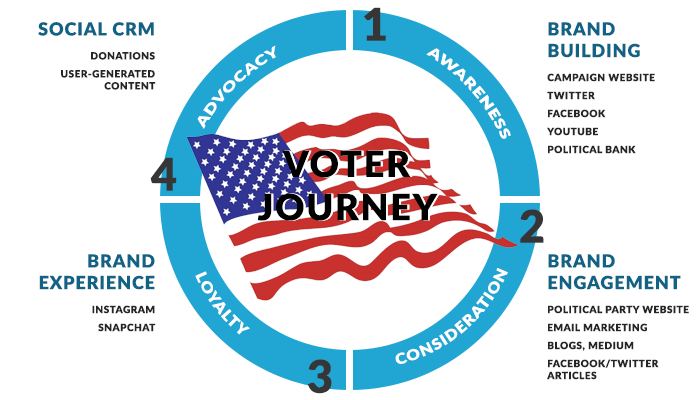Elevating Your Political Brand in a Digital World
If you do not have an online presence in 2018, do you really exist? We live in an age where a constituent can learn more from searching through your social presence online than they can by standing in person and shaking your hand.
Unfortunately, privacy on the Internet does not exist today and especially when it comes to politics. People want to vote for someone they feel like they know and can trust and the first place they are going to turn for information discovery is the web. By digitally branding yourself you are taking control of the conversation, defining your policies and driving your message to a greater audience of constituents online.
The role of technology in politics has altered the way voters obtain and process information and ultimately cast their vote. Technology has the ability to sway public opinion. If the leading role of “fake news” in the US Presidential 2016 election taught us anything, it is that establishing an online presence is equally important in protecting your brand as it is in promoting it. Creating a digital brand is a basic necessity in your campaign, in how you reach your audience, control your message and communicate your policies. Your online brand gives you the platform to say, “This is me, this is my brand, this is my plan, and this is what I can do for you.”
Each social media platform has its personality and purpose whether it is curating educational content, capturing behind-the-scenes moments to increase engagement or cultivating a place for storytelling. Together they work to drive your message and educate constituents about your policies. No one can tell your brand’s story as well as you, so why not harness your digital image to guide voters through the voter journey? In this section, we will review the social and online platforms you will want to familiarize yourself with and demonstrate how they fit into the user experience for constituents. These online resources will be instrumental in creating impressions online and converting viewers into voters.
The Voter Journey
Phase 1: Awareness - Choosing Your Web Address
Building your brand is an important part of the Awareness Phase. In this introduction period, constituents are hearing about you for the first time. Choosing your Web Address is perhaps the most important step you take in your journey. This foundation of your online and email identity will be the beacon for where to find the most consistent and authoritative voice of your campaign. Your campaign website is your handshake to the world, and you want to make a great impression. Your Web Address tells the world who you are and what you do. It needs to be memorable and easily recalled as it will lead to your website, the hub of your digital brand presence (we will go into depth on publishing a website later in this chapter). Social accounts like Twitter, Facebook, and Instagram, will give more context to the political policy expressed on your website and drive your message outward. Share your commercials and promotional video clips on YouTube and create a profile on a site like www.PoliticalBank.vote, an easy-to-use political profile page builder.
Phase 2: Consideration
The Consideration Phase is the educational phase. Many voters turn to their political party’s website to gain credible information about political candidates. Your team will most likely not have control over the political party website, but you will want to make sure your representation is fair and that voters have a clear path to your campaign website and social media accounts. Every person on your email marketing subscription list expressed an interest in your politics when they released their email to your team. Use this to your advantage, and your newsletter as an opportunity to reinforce what makes you the best candidate for the position, educate voters and inspire a call-to-action. Promoting your content is the most important part of this phase. You should spend 20% of your time creating content that focuses on your core issues and changes you inspire to make, and 80% of your time re-purposing and re-optimizing that same content into new messages. Twitter makes it easy. The platform is built to handle an exuberant content calendar, research from ten studies including Buffer and HubSpot even recommends that brands tweet an average of 15 times per day.
Phase 3: Loyalty
In this phase, voters know which candidate has their vote. They will be sharing content that supports their favored candidate, commenting, liking and interacting with your posts on social media and following you on Instagram and Snapchat for the full brand experience.
Phase 4: Advocacy
Advocacy is the conversion phase when a voter becomes an advocate of your campaign. Every action you inspire others to take in this phase will be multiplied by the social network effect and translate into a donation, a volunteer effort, and a vote. Here is where you can capitalize on your advocate’s willingness to share your message with their social networks, expanding your reach and impressions to the entire electorate and nurturing and growing your voter base into the home stretch of the election.


